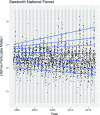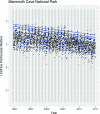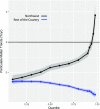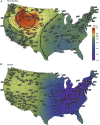US particulate matter air quality improves except in wildfire-prone areas
- PMID: 30012611
- PMCID: PMC6077721
- DOI: 10.1073/pnas.1804353115
US particulate matter air quality improves except in wildfire-prone areas
Abstract
Using data from rural monitoring sites across the contiguous United States, we evaluated fine particulate matter (PM2.5) trends for 1988-2016. We calculate trends in the policy-relevant 98th quantile of PM2.5 using Quantile Regression. We use Kriging and Gaussian Geostatistical Simulations to interpolate trends between observed data points. Overall, we found positive trends in 98th quantile PM2.5 at sites within the Northwest United States (average 0.21 ± 0.12 µg·m-3·y-1; ±95% confidence interval). This was in contrast with sites throughout the rest of country, which showed a negative trend in 98th quantile PM2.5, likely due to reductions in anthropogenic emissions (average -0.66 ± 0.10 µg·m-3·y-1). The positive trend in 98th quantile PM2.5 is due to wildfire activity and was supported by positive trends in total carbon and no trend in sulfate across the Northwest. We also evaluated daily moderate resolution imaging spectroradiometer (MODIS) aerosol optical depth (AOD) for 2002-2017 throughout the United States to compare with ground-based trends. For both Interagency Monitoring of Protected Visual Environments (IMPROVE) PM2.5 and MODIS AOD datasets, we found positive 98th quantile trends in the Northwest (1.77 ± 0.68% and 2.12 ± 0.81% per year, respectively) through 2016. The trend in Northwest AOD is even greater if data for the high-fire year of 2017 are included. These results indicate a decrease in PM2.5 over most of the country but a positive trend in the 98th quantile PM2.5 across the Northwest due to wildfires.
Keywords: Kriging; PM2.5; Quantile Regression; particulate matter; wildfires.
Conflict of interest statement
The authors declare no conflict of interest.
Figures






References
-
- Haikerwal A, et al. Fine particulate matter (PM2.5 ) exposure during a prolonged wildfire period and emergency department visits for asthma. Respirology. 2016;21:88–94. - PubMed
-
- US EPA 2016 Particulate matter (PM2.5) trends. US EPA. Available at https://www.epa.gov/air-trends/particulate-matter-pm25-trends. Accessed September 6, 2017.
-
- Westerling AL, Hidalgo HG, Cayan DR, Swetnam TW. Warming and earlier spring increase western U.S. forest wildfire activity. Science. 2006;313:940–943. - PubMed
Publication types
MeSH terms
Substances
LinkOut - more resources
Full Text Sources
Other Literature Sources
Medical
Research Materials

